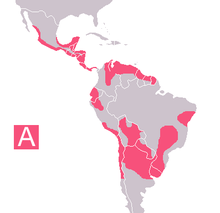Trypanosomiasis
| Trypanosomiasis | |
|---|---|
 | |
| Classification and external resources | |
| Specialty | infectious disease |
| ICD-10 | B56-B57 |
| ICD-9-CM | 086.5-086 |
| MeSH | D014352 |
Trypanosomiasis or trypanosomosis is the name of several diseases in vertebrates caused by parasitic protozoan trypanosomes of the genus Trypanosoma. In humans this includes African trypanosomiasis and Chagas disease. A number of other diseases occur in other animals.
Approximately 30,000 people in 36 countries of sub-Saharan Africa have African trypanosomiasis, which is caused by either Trypanosoma brucei gambiense or Trypanosoma brucei rhodesiense.[1] Chagas disease causes 21,000 deaths per year mainly in Latin America.[2]
Signs and symptoms
The tsetse fly bite erupts into a red chancre sore and within a few weeks, the person can experience fever, swollen lymph glands, blood in urine, aching muscles and joints, headaches and irritability. In the first phase, the patient has only intermittent bouts of fever with lymphadenopathy together with other non-specific signs and symptoms. The second stage of the disease is marked by involvement of the central nervous system with extensive neurological effects like changes in personality, alteration of the biological clock (the circadian rhythm), confusion, slurred speech, seizures and difficulty in walking and talking. These problems can develop over many years and if not treated, the person dies. It is common to the African continent.
Diagnosis
Cattle may show enlarged lymph nodes and internal organs. Haemolytic anaemia is a characteristic sign. Systemic disease and reproductie are common, and cattle appear to waste away.
Horses with dourine show signs of ventral and genital edema and urticaria.
Infected dogs and cats may show severe systemic signs.
Diagnosis relies on recognition of the flagellate on a blood smear. Motile organisms may be visible in the buffy coat when a blood sample is spun down. Serological testing is also common.
Prevention
Diminazene, homidium, isometadium, suramin, and melarsomine can all be used to treat infections. Resistance is increasing in endemic areas and recurrent treatments may be necessary.[3]
The use of trypanotolerant breeds for livestock farming should be considered if the disease is widespread.
Fly control is another option but is difficult to implement.
The main approaches to controlling African trypanosomiasis are to reduce the reservoirs of infection and the presence of the tsetse fly. Screening of people at risk helps identify patients at an early stage. Diagnosis should be made as early as possible and before the advanced stage to avoid complicated, difficult and risky treatment procedures.
Treatment
Diagnosis is often missed in the first phase of the disease due to non-specific nature of symptoms. Pentamidine and Suramin are used for treatment in the first phase. Melarsoprol, nifurtimox and eflornithine are drugs used in second phase of the disease. However none of the therapies available are optimal in terms of adverse events and ease of administration.[4]
Other animals

- Nagana, or animal African trypanosomiasis, also called 'Souma' or 'Soumaya' in Sudan.
- Surra
- Mal de caderas (of central South America)
- Murrina de caderas (of Panama; Derrengadera de caderas)
- Dourine
- Cachexial fevers (various)
- Gambian horse sickness (of central Africa)
- Baleri (of Sudan)
- Kaodzera (Rhodesian trypanosomiasis)
- Tahaga (a disease of camels in Algeria)
- Galziekte, galzietzke (bilious fever of cattle; gall sickness of South Africa)
- Peste-boba (of Venezuela; Derrengadera)
Some species of cattle such as the African buffalo, N'dama, and Keteku appear trypanotolerant and do not develop symptoms. Calves are more resistant than adults.
References
- ↑ WHO. "Trypanosomiasis, Human African (sleeping sickness)". Fact sheet N°259. World Health Organization. Retrieved 25 February 2014.
- ↑ Maya JD, Cassels BK, Iturriaga-Vásquez P, et al. (2007). "Mode of action of natural and synthetic drugs against Trypanosoma cruzi and their interaction with the mammalian host". Comp. Biochem. Physiol., Part a Mol. Integr. Physiol. 146 (4): 601–20. PMID 16626984. doi:10.1016/j.cbpa.2006.03.004.
- ↑ Carsten Wrenger; Isolmar Schettert; Eva Liebau (2013). "Oxidative stress in human infectious diseases – present and current knowledge about its druggability". Drug Development. InTech. doi:10.5772/53758.
- ↑ Lutje, V; Seixas, J; Kennedy, A (Jun 28, 2013). "Chemotherapy for second-stage human African trypanosomiasis.". The Cochrane database of systematic reviews. 6: CD006201. PMID 23807762. doi:10.1002/14651858.CD006201.pub3.
Bibliography
- Thomas, H Wolferstan (1905). Report on trypanosomes, trypanosomiasis, and sleeping sickness : being an experimental investigation into their pathology and treatment. London: University Press of Liverpool. OCLC 11692559.
- Manson, Patrick (1914). Tropical diseases : a manual of diseases of warm climates (5th ed.). New York: William Wood. OCLC 812165069.
- Daniels, Charles Wilberforce (1914). Tropical Medicine and Hygiene. New York. OCLC 810109334.
- Maudlin, Ian; Holmes, Peter; Miles, Michael W (2004). The trypanosomiases. Wallingford, UK; Cambridge, MA: CABI Publishing. ISBN 9780851990347. OCLC 58543155.
External links
- Animal Trypanosomosis reviewed and published by Wikivet.
- Disease card on World Organisation for Animal Health